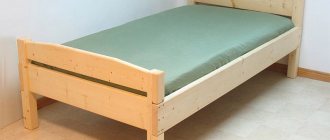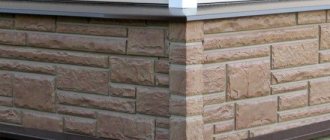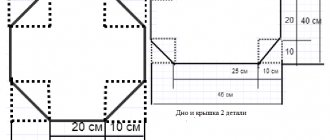With the onset of cold weather, residents of private houses in areas without a centralized gas supply have to think about preparing firewood for the winter. In this matter, the best assistant is a chainsaw, but, unfortunately, such a tool is not capable of chopping wood, so it is important to take care of purchasing or making a wood splitter yourself. The first option involves financial costs, and the second is considered more rational, since it implies minimal investment with the possibility of obtaining a high-quality device. We will pay special attention to the question of how to make a wood splitter with your own hands at home from available materials, but first, let’s figure out what kind of device it is and what types of it exist.
Wood splitter - what is it and what is it for?
A wood splitter is a special machine that consists of three main parts:
- Knife or blade - designed for longitudinal splitting of workpieces.
- The stop is an important structural element that is designed to hold the workpiece when a knife acts on it. The pusher is used in fixed blade installations. Serves to push the workpiece towards the cutting element.
- Drive - a mechanism that drives the knife or thrust part, reducing the distance between these two structural units for the purpose of splitting workpieces.
Often, wood splitters are also called splitting axes or wood splitting machines, which, in addition to longitudinal splitting of logs, are intended for trimming. Such machines are an alternative replacement for hand splitting axes or axes, which are equipped with the function of splitting firewood. Unlike them, the machine allows you to perform work not only faster, but also much better, and most importantly, safer. The likelihood of injury is extremely low, which is due to the absence of rapidly rotating working parts compared to a sawmill. The photo below shows a model of a rack-and-pinion device.
This is interesting! Using a wood splitter, large logs are split into small logs, which are ready for use.
Classification of wood splitters
Procuring firewood on a farm is a frequent task and requires a lot of effort. Before making a homemade device for chopping wood with your own hands, you need to decide on the volume and purpose of the device. The proposed equipment is divided into main categories:
- Mechanical device - the presence of an engine as a drive for a screw or hydraulics, electric and spring energy-dependent wood splitters.
- Design features - rack, vertical, conical, horizontal, and so on; there are a lot of designs for splitting firewood.
- The operating principles can be hydraulic or pneumatic, in the form of a screw.
The cheapest option in terms of design is a mechanical splitting splitter, consisting of a stand and a support table. For more complex designs, such as a cone log splitter, you will need equipment for connecting the engine and the rotating element itself. This machine will significantly increase productivity compared to a mechanical device.
An example of a homemade mechanical wood splitter
Using the appropriate drawings, it is possible to make a more complex rack structure with your own hands. The principle of operation is based on the conversion of rotational energy into translational movements, based on this, additional materials will be needed for manufacturing.
Types of wood splitters by type of drive: manual devices and features of their use
If a private house has a solid fuel boiler, fireplace or classic Russian stove, then you will definitely need to prepare firewood. A key role in this matter is played by a wood splitter, with the help of which round logs are split into small logs ready for burning. For such purposes, you can use wood splitters, which come in different versions depending on the type of drive. The choice of the appropriate type is made depending on the size of the logs to be split, as well as the amount of work. If you have a large amount of firewood, it is more rational to purchase or make your own wood splitter using a mechanical operating principle. Let's look at the differences between manual and mechanical wood splitters.
Manual cleavers are distinguished by their simple design, but their main advantage is their affordable price. However, before choosing this device option, you need to navigate the volume of firewood being processed. Factory-produced products come in different types, but the most popular modifications are:
- The classic manual version - the device consists of a base with a fixed blade, the edge of which is directed upward. The operating principle of such devices is quite simple and requires minimal effort. To split the deck into pieces, you need to place it on the blade and hit the top of the workpiece with a hammer. In order not to hold the deck with your hand, the device is equipped with a stop, thanks to which the workpiece is held on the knife. A device of this format has many advantages, namely simplicity of design and operation, affordable cost and the possibility of self-production. However, when purchasing such a device, take into account some of the disadvantages, namely: the limited diameter of the logs that can be split. This depends on the diameter of the support circle. It is also important to take into account the force of impact on the deck, since applying it excessively can lead to contact of the sledgehammer with the support or blade, and the result of this consequence is deformation of the edge and failure of the device. It is also recommended to fix the base to the surface to prevent it from turning over after striking. The photo below shows the design of a simple hand cleaver, which is not difficult to make with your own hands.
- Crowbar - a device consisting of a pipe, the lower part of which has a knife. A heavy rod with rubberized handles located perpendicularly moves inside the pipe. This rod is also called a crowbar, hence the name of the device, which, hitting the lower part with the blade, splits the deck. An important detail is the rod handles, which are needed to hold the device and apply additional effort. Making such a device with your own hands is also not difficult, for which you will need to use a pipe and fittings. The biggest disadvantage of this type of cleaver is that it requires significant physical effort to achieve a positive result.
- Spring or foot cleaver - this type of device has a semi-automatic operating principle, which involves the use of a spring mechanism. The structure consists of a base with a moving part on which the workpiece is installed. When you press on a special heel, the support is compressed, which presses the deck to the edge of the knife, thereby splitting the wood. Eliminates the need for manual effort, but this version of the device is not suitable for working with hard wood.
The main types of manual wood splitters are described above, the main advantages of which are affordable cost and ease of operation. Below is a video of how a homemade crowbar cleaver works, so that anyone can be guided by the features of its operation.
Preferring the simplest and most inexpensive type of hand cleaver, you need to pay attention to the features of its operation, which is shown in detail in the video.
As you can see, the devices cope with decks of different sizes, however, it is very important to control the impact force in order to eliminate the possibility of deformation of the cutting edge. If you are considering a foot type of cleaver, then the principle of its operation is shown below.
It is important to note that semi-automatic models of cleavers are not much more expensive, but they are an alternative option for people who cannot wield a sledgehammer or crowbar, that is, for women or the elderly.
This is interesting! Wood splitters are one of the most popular devices not only in villages and villages, but also among owners of country houses or even urban private houses that have fireplaces, boilers or stoves. The choice of a hand cleaver is rational only if it has to be used infrequently for processing small volumes of wood. When working with a large volume of firewood, it is recommended to consider varieties of mechanical splitting axes.
DIY hydro splitter
Making a hydraulic splitter for firewood is not difficult. The main snag is in its hydraulic part, circuit, connection methods and calculation of components, which we will consider.
We will not consider in detail the structure of the body, work table, wedge, transportation capabilities and similar functions, for the simple reason that they mainly depend on the imagination and needs of a particular master. They do not affect the main task of the cleaver in any way. But we will still provide a number of general recommendations below.
The minimum that a simple hydraulic wood splitter can consist of is:
- hydraulic pump;
- hydraulic pump drive (engine);
- hydraulic distributor;
- hydraulic tank;
- hydraulic cylinder;
- sleeves;
- connecting elements.
Before constructing a homemade hydraulic splitter, you need to decide on its power, namely, how much hydraulic cylinder force is required. An error at this stage leads to the fact that the drive power may not be enough. Accordingly, the engine will jam on knotty wood or large logs.
You can see the hydraulic diagram of a simple wood splitter in the photo. It includes a minimum of components. It is worth paying attention to the presence of its own safety valve at the hydraulic distributor. Its presence will not help in any way to improve or simplify the main task of the device, but it always needs to be installed.
If the distributor does not have one, then an independent valve must be installed in the system.
You can also use the hydraulic system calculation calculator: https://gik43.ru/articles/raschet_gidrotsilindra.html
It is necessary to clearly understand the rule of the inverse relationship between the performance of the hydraulic system and the drive power required for this. With such a calculation in this scheme, you always have to sacrifice the speed of the hydraulic cylinder in favor of lower engine power. But this is not always suitable. The industry requires a combination of high cycle speed and low power consumption. In this case, a unique type of load will help: a large idle stroke of the hydraulic cylinder and a short loaded mode. Here you need to divide the flows to the hydraulic cylinder according to performance depending on the operating mode.
The diagrams below solve a similar problem. 2 pumps with different volumes from one drive or a double pump with different volume sections are used. For example, pumps NSh32 and NSh10 are presented.
The idle speed of the hydraulic cylinder is ensured by the total flow of both pumps; the safety valve in this case is set to a pressure much less than that required to ensure the working cycle (splitting). When the hydraulic cylinder rests on the workpiece, the increased pressure in the NSh32 hydraulic line is released through the safety valve into the tank, and the check valve limits the hydraulic line only to the flow and pressure created from NSh10. The diagram just shows a loaded hydraulic line from NSh10. After splitting the workpiece, the pressure in the system drops sharply and the safety valve closes and the cylinder is again fed by the total flow. All this leads to high performance of the cleaver in idle mode, as well as to saving power of the drive motor in loaded mode.
To use the hydraulic splitting splitter solution with two pumps, we present a more complete, recommended scheme
Source of diagrams: https://gik43.ru/articles/drovokol_svoimi_rukami.html
Types of mechanical cleavers for firewood: their advantages and functional features
There are many more types of mechanical wood splitters than manual ones. This is due to the wide variety of types of drives used. However, the advantage of mechanical devices lies not only in the virtual absence of physical effort, but also in the ability to split large-sized firewood. Split firewood is much easier to cut into small logs than to cut large logs.
The operating principle of mechanical wood splitters is based on the following manipulations:
- laying or installing logs in a special chute;
- the drive (there are different types) drives the supporting part or cutting blade, thereby influencing the workpiece;
- the knife digs into the wood, as a result of which the workpiece splits into two or more parts, which also depends on the design of the knife.
The undeniable advantage of such units is also their high speed of operation, as well as the ability to process large volumes of firewood. It should be noted that thanks to mechanical wood splitters, it is possible to split wood of various species, which manual devices cannot always cope with.
Like manual wood splitters, mechanical devices can also be made by yourself. Moreover, you don’t need to buy anything for this, since the devices can be made from improvised materials that are available in your garage. Actually, we will pay special attention to this, but first we will consider what types of mechanical devices are divided, and how they differ.
Types of mechanical devices by power source
The most important structural element of all mechanical wood splitters is the drive. Based on the type of drive mechanisms, wood splitters are divided into the following types:
- Electric with a rotating drill - models that use a cone-shaped working part, which is driven by an electric motor. Due to the specific shape of the working part, the cone is also called a carrot, which splits lumps by cutting into the wood and deepening into it. Such devices work on the principle of screwing a screw into wood, only the leg of such an element increases in diameter as it enters the workpiece. Depending on the hardness of the wood, it splits into different numbers of logs. These types of wood splitters are easy to make with your own hands at home, since they consist of an electric motor with a cone-shaped working body.
- Electric ones with a hydraulic pump are very popular because they are highly reliable and efficient. Such models are the best option for domestic use, but their main drawback, like the first types, is the need to be located near electrical energy sources. The principle of their operation is as follows: upon startup, oil pressure is pumped into the cylinder, which is manually driven using special buttons or handles. After placing the workpiece in a special groove, a signal is given for compression, during which either the supporting part or the cutting knife moves, acting on the log. After splitting, the moving part also returns to its original position upon a signal. The operating principle of such units is not only simple and reliable, but also safe. The worker should only operate the moving part and control the process.
- Rack and pinion splitters are another type of wood splitter, which are an alternative replacement for devices with hydraulic cylinders. They are distinguished by a simplified design and increased reliability, but at the same time they have significantly less compression force than hydraulic models. Electric motors or gasoline internal combustion engines can be used as a drive.
- With gasoline engines - the use of gasoline engines as a drive has clear advantages over electric counterparts. The first advantage is their mobility, that is, such installations are not tied to an electrical outlet and can be used in field conditions. The second advantage is increased power ratings, which allows them to cope with workpieces of different hardness and size. Such units are used not only in everyday life, but also on an industrial scale.
- Wood splitters with traction from the PTO power take-off shaft - the main advantage of such units is that they have significant power indicators compared to electric and gasoline counterparts, but their main disadvantage is their attachment to automotive equipment, which is equipped with a power take-off shaft. Such equipment is used in forestry, in enterprises and various farms, where there are not only large volumes, but also the processing of large-sized workpieces is required.
- Combined models are used extremely rarely in everyday life, which is due to their high cost. They are equipped with two types of drives, for example, PTO and electric motor, which allows you to operate the equipment depending on its location: in the courtyard of a private house, where electricity is available, or in the field.
For domestic use, models equipped with electric and gasoline engines are best suited. If you have at your disposal an unnecessary electric motor or drive from a walk-behind tractor, then you can make a wood splitter yourself, eliminating the need for large financial costs.
Types of hydraulic wood splitters
Let's take a closer look at the design of these mechanisms to understand the principle of their operation and choose the appropriate option for yourself.
According to the number of operations performed, all wood splitters are divided into household and professional. The former only split firewood, while the latter are equipped with additional devices for feeding, trimming and unloading.
Depending on the position of the log being split, hydraulic splitters are divided into three types:
- Horizontal. The log is placed on a horizontal trench. There are two operating schemes for such devices. In the first case, the knife is fixed on the frame, and the pusher moves a piece of log towards it. In the second option, the log stands motionless on the stop, and the hydraulic drive feeds the knife to it.
- Vertical. The log stands vertically, and the knife is fed from above and splits it. The advantage of this scheme is higher productivity and compactness of the installation. The disadvantage is the need to hold the log with your hands, which increases the risk of injury.
- Mixed. Such mechanisms can operate in both vertical and horizontal modes. Used in industrial woodworking.
Another distinctive feature of hydraulic log splitters is the type of engine.
A household hydraulic cleaver is equipped with an electric motor that rotates the hydraulic pump. This drive has three important advantages: reliability, ease of maintenance and environmental friendliness. The disadvantage is the strict dependence on the power supply network.
More powerful mobile wood splitters are equipped with gasoline or diesel engines. They are used by professional loggers.
For forestry, farmers and commercial enterprises, mobile models have been created that operate from the hydraulic system of the tractor or from its power take-off shaft.
There are universal mechanisms that can operate from an electric motor and tractor drive or from a gasoline engine and tractor hydraulics.
The price of a household hydraulic wood splitter, depending on the brand, engine power and frame design, ranges from 9,000 to 32,000 rubles. Powerful models designed for splitting firewood in large volumes cost much more: 70,000 - 120,000 rubles and more.
Types of devices by method of movement
Equipment is classified according to the criterion of mobility. They can be mobile or stationary, which affects the features of their operation. When choosing the appropriate option, you need to take into account its features:
- Stationary products are characterized by massive dimensions and heavy weight, so they are intended for use in one place. It is not advisable to operate such installations in everyday life, due to the complexity of their transportation. At the same time, they have such an undeniable advantage as high power ratings, which allows them to be used for working with the hardest types of wood: walnut, oak, beech.
- Mobile or portable - in addition to their compact size and light weight, such installations are equipped with transport wheels, thanks to which the equipment can be moved to another location independently and without the help of special equipment. These types of installations are the best types for domestic use.
The choice of the appropriate option depends on various factors, for example, frequency of use, place of use, volume of work, hardness and size of wood, etc. If chopping wood is done only at home, then you can use stationary installations, which have increased technical and operational parameters.
What types of wood splitters are there according to the principle of their functioning?
Installations are classified into types depending on such parameters as the type of knife mechanism used and the method of driving it. Before purchasing a suitable equipment option or starting to manufacture it, it is necessary to determine the design differences, as well as the presence of corresponding advantages and disadvantages.
According to the type of execution of working elements on wood splitters, they are:
- knife or guillotine - they consist of a cone-shaped knife that splits logs by cutting into them. Such devices are characterized by increased safety, since they do not rotate. Their main disadvantage is that over time they require sharpening of the cutting edge. Knife devices also have an advantage - the ability to split wood in the required place and into the required number of logs;
- screw - the working body is presented in the form of a cone-shaped element - a drill, which has cutting spiral edges, through which it is screwed into the wood and splits or tears it into pieces. They are characterized by increased efficiency, but at the same time they have low safety indicators. It is important to carefully control the process, especially when the logs are fed into the rotating blade manually. It is impossible to predict how many pieces the log will be split when using such cleavers, which is sometimes a disadvantage (why sometimes, since the more logs the log is broken into the first time, the better, but sometimes it is necessary to obtain not too small pieces).
It is also important to take into account that screw cleavers practically do not require sharpening of the cutting edges, therefore they are characterized by a long service life. The choice of the appropriate option should be based on operational features. For example, if it is important to obtain logs of the same size, then preference should be given to knife-type installations.
Wood splitting machines are also divided into types based on the method of actuating the cutting part. If everything is clear with screw-type installations (their working element rotates along an axis), then with knife-type devices, not everything is so simple. They are divided into the following types:
- The knife is stationary - installations in which the compression of the log occurs due to the movement of the supporting heel. The heel acts on the workpiece, pressing it against the knife element, thereby splitting the wood. The advantage of such installations is an increased degree of safety, since the knife is always stationary. The installations are also distinguished by their simplicity of design, which has a positive effect on their cost. When the cutting edge becomes dull, the knife can be removed and sharpened or even replaced with another, which takes no more than 5 minutes.
- With movable knives - they differ from the previous version in that it is not the supporting part that is driven, but the cutting element. The advantages of such installations are that it is possible to carry out more precise actions for splitting logs. However, the installations are considered less safe, since during the movement of the knife, fingers can get under its cutting edge, which will lead to adverse consequences. In addition, since the knife is mounted on the hydraulic cylinder rod, this complicates not only the design, but also the specifics of removing it for replacement or sharpening.
It is also important to note that the installations are divided according to the method of arrangement of the workpieces. The machines come with vertical and horizontal installation of logs, which affects the ease of their operation. Most modern models have horizontal loading of workpieces, and the vertical type is often used when working with long logs.
This is interesting! The knife on knife log splitters can have different configurations. The simplest are products with one edge, which divide the workpieces in half. To work with large logs, it is rational to use cutting elements with two or more cutting edges that are shaped like a cross or a star. Cross blades cut the workpiece into 4 parts at once, and with a star-shaped blade, into a larger number of logs.
Product Features
A wood splitter is always useful on the farm; you can either buy it ready-made or make it yourself using available materials. Ready-made options have been improved; there are a number of additional functions that allow you to chop maximum firewood in a short time.
There are many installations operating in an automated format. This is good, because you can not waste time on work, but start a machine that will do everything itself. Experts identify several signs that can be used to classify mechanisms into categories :
- Depending on the method of stacking logs, machines can be vertical or horizontal. Sheer structures are considered more powerful and durable, since they can process even a thick deck in a short period of time. If the logs are crooked or have many irregularities, then it is better to give preference to the horizontal mechanism.
- Maximum amount of stacked firewood. Depending on this criterion, equipment can be divided into equipment for home use and for industrial use.
- Drive types. For home use, a machine with a low power electric type is suitable.
In this video we will look at a hydraulic wood splitter:
The mass of the unit also plays a role: the larger it is, the harder it will be to move the structure or carry out technical inspection during operation. It’s not difficult to create a machine for chopping wood with your own hands. The main thing is to find the right drawing of a wood splitter and apply it in practice.
Characteristics of wood splitters and their main technical parameters
Before you study the features of making wood splitters yourself, you should pay attention to the most important parameters of wood splitters. These include:
- Splitting power of the workpiece - it is also called the amount of force that is applied to the log to split it. This parameter is typical for units that use blade working elements. For home use, a force of 3-7 tons is quite sufficient. For screw-type products, an important parameter is the rotation speed of the drill, which affects not only the speed of work, but also the efficiency of performing the corresponding actions. The optimal drill speed parameter is a value in the range from 400 to 600 rpm. This value is important to consider if you plan to make a screw wood splitter with your own hands when choosing a suitable electric motor.
- Working length or distance between the support and the cutting part. This value indicates the ability to work with logs of a certain length. Most often, splitting of logs up to 30 cm in length is carried out, but sometimes this value can be larger. For example, in industry, workpieces from 50 to 100 cm are used. In everyday life, it may also be necessary to split long logs if you need to save on the fuel consumption of a chainsaw (cutting split logs is easier and less expensive than full-fledged logs).
- The diameter of the workpieces - for electro-hydraulic machines, this figure is up to 30 cm. If you use a cone unit, then the diameter of the workpiece does not matter, since the drill can cope with logs of almost any size.
- Piston stroke. Knife machines also differ in such a parameter as the distance of movement of the piston. Everyone distinguishes two categories of machines: in which the piston is extended to its fullest part and then returned to its original position, as well as more energy-intensive devices where the rod is controlled by the operator. If the log splits immediately, but the knife has not traveled even half the distance, then the operator can return it to its original position using a limiter. Thus, not only energy consumption is saved, but also work execution time.
- The speed of the rod movement is an important indicator that is important to take into account, since the duration of the work depends on it. For domestic installations, the optimal value is a forward speed of 4 cm/second. The reverse stroke is performed at a speed increased by 2 times, that is, 7-8 cm/sec.
- The power of the drive unit affects the performance of the equipment, as well as the force of splitting logs. For hydraulic machines, motors are used that have a power reserve of 1.5 kW.
When choosing equipment, it is important to take into account one more factor - the material from which the knife is made. Not only their efficiency and durability, but also the frequency of maintenance depends on this. Once the main types of wood splitters are known, attention should be paid to the issue of making them independently from improvised means. Making a wood splitter with your own hands is not difficult, but for this you will need a minimum set of tools: angle grinder or grinder, drill, welding machine and others.
Mechanical wood splitters
A small amount of work can be done using a simple device. The wood splitter has a simple design and can be made from any available material. The performance of this device is low, but it makes it possible to safely prepare firewood with your own hands. There are few advanced devices for chopping wood that can be made at home.
The easiest and simplest option for assembling a wood splitter with your own hands is similar in design to a well crane. The racks are connected in a hinged manner; instead of a container, handles with a cutter are installed. This mechanism works due to physical force. Assembly can be done from any available materials; you will need corners and several pipes; you can use a broken ax as a cutter.
Mechanical wood splitter diagram
A self-made mechanical cleaver has a number of disadvantages. For a more simplified process, an extended lever should be used, which affects the dimensions of the mechanism. The most common option is to install a lever system with a heavier cleaver. Due to the increased mass, the structure is easiest to pour concrete into the ground. This device is more compact and more efficient than its competitor.
How to make a wood splitter with your own hands: instructions for making a simple screw unit
Screw wood splitters are considered the simplest units, as they require minimal effort not only for their manufacture, but also during operation they are characterized by increased efficiency and ease of operation. The photo below shows the design of a homemade cone wood splitter, the independent production of which we will consider in detail.
To make such an installation, you will need a welding machine and the help of a turner. To implement your idea, it is important to perform the following steps:
- Prepare a metal table. You can use a frame from a circular saw or make it yourself from corners and sheet steel 3-4 mm thick.
- Selecting an electric motor. It is important to use a powerful motor whose shaft rotation speed is no more than 2000 rpm. If the engine is connected to a single-phase network, then it will need to be switched on through a block of capacitors of a certain capacity, which depends on the power of the power plant.
- Selection of pulleys - it is recommended to use double-groove pulleys, which eliminate the possibility of their slipping and increase their service life. Moreover, the diameters of the drive and driven pulleys must be different. If the motor rotation speed is 1500-2000 rpm, and it is necessary to ensure rotation of the cone at a speed of 500-600 rpm, then it is necessary to install a driven shaft pulley with a diameter twice as large. In this way it will be possible to reduce the speed and increase the torque. Pulleys can be used from agricultural machinery or elevators.
- The driven shaft is turned by a turner, and a pulley is mounted on it. To secure the shaft, rolling bearings are used.
- At the other end of the shaft, fix a cone drill, which is recommended to be purchased, since turning it from a turner will cost the same as the cost of a new part.
- The driven shaft is fixed using metal arcs, which can be made independently from a pipe of the appropriate diameter and steel plates. However, it is much easier to purchase supports along with bearings.
- It is important to provide for adjustment of the belt drive tension, which can be achieved by changing the distance between the engine platform and the surface of its installation.
Instead of a belt drive, a chain drive can be used, which will increase the efficiency and reliability of the design.
After manufacturing such a structure, it is necessary to take into account the features of working with it. As described above, such installations are characterized by unsafe operation, which is associated with the presence of rotating parts. When operating a screw log splitter, it is important to consider the following recommendations for compliance with safety regulations:
- It is strictly contraindicated to work in clothes with hanging sleeves, as they can get into the working part, which will lead to them being wrapped around the conical part.
- It is contraindicated to perform work wearing gloves made of fabric, which can also be wound around the conical part.
- Not located on the side where the pulleys are located when the unit is running.
- When carrying out work, hold the workpiece with both hands. Hold the log with one hand from above, and the other from the end side, as shown in the photo below. This rule must be followed in order to eliminate the possibility of injuring your fingers when turning the log.
A video of a homemade cone log splitter in operation is presented below.
An example of making a similar wood splitter can also be seen in this video clip.
When planning the manufacture of this version of the wood splitter, it is necessary to take into account the features of its functioning. If such a tool suits you, then you can safely start making it yourself.
Do-it-yourself knife wood splitter from a traction winch
Making a knife log splitter has some difficulties. To construct such an installation at home, you will need a large number of parts, so their manufacture is not always rational, unless you have a gear unit and an electric motor at your disposal. Next, we will consider the features of manufacturing a wood splitter for splitting knife-type firewood from an old traction winch, which consists of a power unit and a gearbox.
- The drive mechanism is a 3.2 kW electric motor with a shaft rotation speed of 1500 rpm.
- The motor shaft is connected to a gearbox, which at the output of the driven shaft has a rotation speed of 10 revolutions per minute. This speed is enough to have time to install logs for splitting.
- The rod is made from a truck axle shaft, the length of which is 1 meter. Its role is as a stop, with the help of which the logs are pressed against the cutting knife.
- The thrust heel is made from a 120 mm angle.
- The stop moves along a surface made of an I-beam.
- The knife is made from tractor attachments.
If you have a gear unit, making such a design will not be difficult. At the same time, the installation is characterized by high productivity. The structural elements can be placed on a frame with wheels, which will allow the installation to be transported. How a wood splitter works in action is shown in the video below.
Based on the information described, it will not be difficult to make a wood splitter yourself, saving your finances and getting a high-performance unit for home use.
Vertical inertial wood splitter
A manual vertical wood splitter, the mechanism of which consists of a metal pipe connected by a hinge to a support, helps to quickly split firewood. A cutting element for splitting is installed at the end of the pipe, increasing the force of the load.
This type of homemade wood splitter works by sharply lowering the pipe down, which, under the influence of the load, splits the wood. The advantage of the machine is the availability of composite materials that can be found in your own or a neighboring garage.
Inertial vertical wood splitter
The disadvantage is the increased weight of the cutting device; a person will not be able to work for a long time due to fatigue.
Varieties of do-it-yourself wood splitters: options with photos and videos
Making a wood splitter at home with your own hands is not very difficult if you have the necessary tools and available materials at your disposal. Below is a list of various options for wood splitters, based on which you can make a design yourself.
- The simplest screw wood splitter consists of a motor and a cone drill. The drill is mounted on the electric motor shaft. It is important to take into account one condition - the engine shaft rotation speed should be no more than 700 rpm.
- An electric wood splitter made from a gearbox is a knife-type device, for the manufacture of which you will need a gearbox, an electric motor, as well as a welding machine and metal parts. A photo of such a device is presented below.
- You can make another type of wood splitter from the gearbox. A steel plate with a knife can be installed on the output shaft of the gearbox, which rotates and splits wood. This installation option is characterized by ease of operation, but at the same time it is not safe to use and requires increased attention and attention class=”aligncenter” width=”800″ height=”407″[/img]
- You can make your own manual wood splitter. To do this, you will need a car spring, which is the basis of the design. The installation itself is made of metal channel. A cutting knife with a weighting material and a handle is welded to the end of the working part.
When using such a setup, great physical effort is required. A diagram of such a device is presented below.
Various options for wood splitters in operation are presented below:
A rack-and-pinion version made from improvised means.
Manual spring unit in operation.
Knife wood splitter from a gearbox. It is worth paying attention to this handmade model. It features high performance and safe operation.
Which version of the wood splitter to make at home depends on the availability of appropriate available tools. If you have a gasoline engine, you can make an autonomous unit for use in the field. In most cases, an electric motor is required for the manufacture of mechanical units. If it is not available, it is recommended to consider manual installation options.
To summarize, it should be noted that there are a lot of options for making wood splitters, but which one to choose for yourself depends only on your capabilities and the availability of appropriate means at hand.
Lastly about hand axes
If you do not have the opportunity to make a mechanized wood splitter yourself, you will have to chop firewood in the traditional way. Here it is important to choose a convenient tool that will make the work as easy as possible.
How to choose axes for chopping wood:
- Stores sell cleavers with different handle lengths and blade weights (2-5 kg). Buy a tool that suits your physical form, because you need to swing an ax often and for a long time. You should not immediately take the heaviest specimens.
- The wooden ax handle of quality products is planed from elm, maple or birch. These rocks do not crumble into chips or split.
- Do not buy an ax with a handle that is too short, which reduces the power of striking. An overly long ax handle can be easily cut to the required size.
- Make sure that the “head” sits tightly on the handle.
If your budget allows, you should pay attention to more practical imported cleavers with a durable plastic handle and various blade profiles made of high-quality steel. Popular options are straight axes from the Fiskars brand and wood splitters with a shifted center of gravity from the manufacturer Vipukirves.











